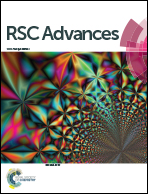Enhancing the thermoelectric power factor of nanostructured ZnCo2O4 by Bi substitution
Abstract
BixZnCo2−xO4 (0 ≤ x ≤ 0.2) nanoparticles with different x values have been prepared by the sol–gel method; the structural, morphological, thermal and thermoelectric properties of the prepared nanomaterials are investigated. XRD analysis confirms that Bi is completely dissolved in the ZnCo2O4 lattice till the x values of ≤0.1 and the secondary phase of Bi2O3 is formed at higher x value (x > 0.1). The synthesized nanomaterials are densified and the thermoelectric properties are studied as a function of temperature. The electrical resistivity of the BixZnCo2−xO4 decreased with x value and it fell to 4 × 10−2 Ω m for the sample with x value ≤ 0.1. The Seebeck coefficient value increased with the increase of Bi substitution till the x value of 0.1 and decreased for the sample with higher Bi content (x ≤ 0.2) as the resistivity of the sample increased due to secondary phase formation. With the optimum Seebeck coefficient and electrical resistivity, Bi0.1ZnCo1.9O4 shows the high-power factor (α2σ550 K) of 2.3 μW K−2 m−1 and figure of merit of 9.5 × 10−4 at 668 K respectively, compared with other samples. The experimental results reveal that Bi substitution at the Co site is a promising approach to improve the thermoelectric properties of ZnCo2O4.



 Please wait while we load your content...
Please wait while we load your content...